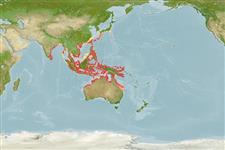Environment: milieu / Zona climática / intervalo de profundidade / distribution range
Ecologia
marinhas; estuarina associadas(os) a recifes; intervalo de profundidade 1 - ? m (Ref. 48637), usually 1 - 20 m (Ref. 27115). Tropical; 23°C - 28°C (Ref. 27115); 35°N - 25°S, 77°E - 154°E
Indo-West Pacific: southern India, Sri Lanka, Andaman Islands, Thailand, southern and eastern coasts of China, Taiwan, Ryukyu, Philippines, Malaysia, Singapore, Indonesia and Northern Territory in Australia.
Tamanho / Peso / Idade
Maturidade: Lm ? range ? - ? cm
Max length : 30.0 cm TL macho/indeterminado; (Ref. 9710); common length : 20.0 cm TL macho/indeterminado; (Ref. 9813)
Espinhos dorsais (total) : 13; Raios dorsais (total) : 10; Espinhos anais: 7; Raios anais : 9; Vértebras: 13. A brown band running diagonally from nape to chin; another from 4th-5th dorsal spine base to pectoral fin base; ocular and shoulder bands spotted with blue; a zone of silvery yellow posterior and adjacent to the shoulder band. Preopercular angle 100°-111°; cheek scalation variable from few to almost fully scaled; midline of thorax fully scaled, sometimes with a row missing from pelvic ridges. A prominent rim or short tube encircle the anterior nostril, with a little peak on it posteriorly. Spines stout, fairly pungent and venomous.
Body shape (shape guide): short and / or deep; Cross section: compressed.
Inhabits shallow coastal waters, around hard coral reefs and areas of sand with patches of rock and soft coral. Tolerant of murky waters. Larger juveniles and adults occur in pairs in coastal reef flats, slopes and estuaries . Small juveniles are found in mangroves and enter freshwater, moving to reefs usually in small groups among corals (Ref. 48637). Feed on benthic seaweeds (Ref. 9813).
Ciclo de vida ou comportamento de acasalamento
Maturidade | Reprodução | Desova | Ovos | Fecundidade | Larvas
Woodland, D.J., 1990. Revision of the fish family Siganidae with descriptions of two new species and comments on distribution and biology. Indo-Pac. Fish. (19):136 p. (Ref. 1419)
Status na Lista Vermelha da UICN (Ref. 130435: Version 2025-1)
Uso pelos humanos
Pescarias: pouco comercial; Aquário: Espécies comerciais
Ferramentas
Relatórios especiais
Baixar XML
Fontes da internet
Estimates based on models
Preferred temperature (Ref.
123201): 25.4 - 29.1, mean 28.3 °C (based on 1192 cells).
Índice de diversidade filogenética (Ref.
82804): PD
50 = 0.5000 [Uniqueness, from 0.5 = low to 2.0 = high].
Bayesian length-weight: a=0.01905 (0.01036 - 0.03504), b=3.13 (2.97 - 3.29), in cm total length, based on LWR estimates for this species & Genus-body shape (Ref.
93245).
Nível Trófico (Ref.
69278): 2.7 ±0.31 se; based on food items.
Resiliência (Ref.
120179): Elevada, tempo mínimo de duplicação da população menor que 15 meses (Preliminary K or Fecundity.).
Fishing Vulnerability (Ref.
59153): Low vulnerability (20 of 100).
🛈
Nutrients (Ref.
124155): Calcium = 38.5 [18.8, 90.0] mg/100g; Iron = 0.671 [0.313, 1.534] mg/100g; Protein = 19 [18, 20] %; Omega3 = 0.121 [0.063, 0.240] g/100g; Selenium = 20.3 [7.8, 50.6] μg/100g; VitaminA = 33 [9, 121] μg/100g; Zinc = 1.42 [0.56, 3.07] mg/100g (wet weight);
